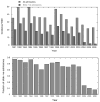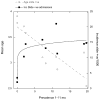Relationship between exposure, clinical malaria, and age in an area of changing transmission intensity
- PMID: 18689622
- PMCID: PMC2547116
Relationship between exposure, clinical malaria, and age in an area of changing transmission intensity
Abstract
The relationship between malaria transmission intensity and clinical disease is important for predicting the outcome of control measures that reduce transmission. Comparisons of hospital data between areas of differing transmission intensity suggest that the mean age of hospitalized clinical malaria is higher under relatively lower transmission, but the total number of episodes is similar until transmission drops below a threshold, where the risks of hospitalized malaria decline. These observations have rarely been examined longitudinally in a single community where transmission declines over time. We reconstructed 16 years (1991-2006) of pediatric hospital surveillance data and infection prevalence surveys from a circumscribed geographic area on the Kenyan coast. The incidence of clinical malaria remained high, despite sustained reductions in exposure to infection. However, the age group experiencing the clinical attacks of malaria increased steadily as exposure declined and may precede changes in the number of episodes in an area with declining transmission.
Figures




References
-
- Snow RW, Omumbo JA, Lowe B, Molyneux CS, Obiero JO, Palmer A, Weber MW, Pinder M, Nahlen B, Obonyo C, New-bold C, Gupta S, Marsh K. Relation between severe malaria morbidity in children and level of Plasmodium falciparum transmission in Africa. Lancet. 1997;349:1650–1654. - PubMed
-
- Trape JF, Quinet MC, Nzingoula S, Senga P, Tchichelle F, Carme B, Candito D, Mayanda H, Zoulani A. Malaria and urbanization in Central Africa—the example of Brazzaville. 5. Pernicious attacks and mortality. Trans R Soc Trop Med Hyg. 1987;81:34–42. - PubMed
-
- Snow RW, Deazevedo IB, Lowe BS, Kabiru EW, Nevill CG, Mwankusye S, Kassiga G, Marsh B, Teuscher T. Severe childhood malaria in 2 areas of markedly different falciparum transmission in East Africa. Acta Trop. 1994;57:289–300. - PubMed
-
- Marsh K, Snow RW. Malaria transmission and morbidity. Parassitologia. 1999;41:241–246. - PubMed
-
- Smith T, Killeen G, Lengeler C, Tanner M. Relationships between the outcome of Plasmodium falciparum infection and the intensity of transmission in Africa. Am J Trop Med Hyg. 2004;71:80–86. - PubMed
Publication types
MeSH terms
Grants and funding
LinkOut - more resources
Full Text Sources
Medical
